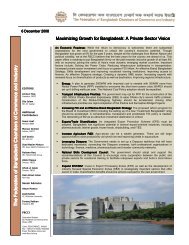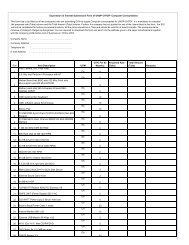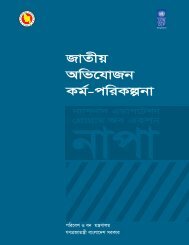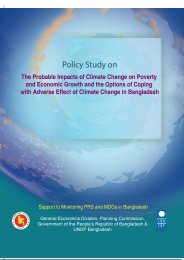Framework for a Strategy of UP Revenue/Resource Mobilisation ...
Framework for a Strategy of UP Revenue/Resource Mobilisation ...
Framework for a Strategy of UP Revenue/Resource Mobilisation ...
You also want an ePaper? Increase the reach of your titles
YUMPU automatically turns print PDFs into web optimized ePapers that Google loves.
the Ministry <strong>of</strong> LGRDC in 2003, assessment should be based on the 7% <strong>of</strong> the annual value <strong>of</strong> the<br />
property with the maximum ceiling <strong>of</strong> Taka 500 <strong>for</strong> any one property (including the land on which<br />
the property is situated, but not agricultural land). Tax is to be assessed and levied on the basis <strong>of</strong><br />
the Annual Rental Value (ARV) on constructed properties, buildings (building includes any shop,<br />
house, hut, outhouse, shed, stable or enclosure built from any material and used <strong>for</strong> any purpose) or<br />
land (excluding agricultural land) at a rate <strong>of</strong> up to 7%. ARV can either be determined from actual<br />
rents if the building is rented (or if it is not, from rental data <strong>for</strong> comparable buildings), or<br />
calculated from construction costs. Regulations specify the way the tax would be calculated. Even<br />
where the house is owner occupied, rental value can be determined based on rents <strong>for</strong> equivalent<br />
properties. The rate <strong>of</strong> 7% <strong>of</strong> the annual rental value (ARV) can be applied to assess the holding tax<br />
(buildings and land) <strong>for</strong> wholly let-out buildings or <strong>for</strong> wholly occupied buildings as well as partly<br />
rented and partly occupied buildings. Where rental value data does not exist, the capital value <strong>of</strong> the<br />
house can be estimated, using Public Works Department’s (PWD) construction cost figures<br />
converted to rental value by applying a 7.5% rate <strong>of</strong> return and adding the ground rent <strong>for</strong> the land.<br />
The assessment is then calculated as 10/12 ths <strong>of</strong> the annual rental value allowing deduction <strong>of</strong> two<br />
months rent as the cost <strong>of</strong> maintenance, if it is rented house and also deductions <strong>of</strong> annual interest <strong>of</strong><br />
the loan if the house is built with bank loan. After deduction <strong>of</strong> two months rent plus annual<br />
interest, tax would be calculated at the rate <strong>of</strong> 7% <strong>of</strong> ARV. If the house is occupied by the owner<br />
than the provision <strong>for</strong> the deduction <strong>of</strong> further one-fourth <strong>of</strong> the rental value after deducting 2/12 ths<br />
<strong>of</strong> the annual rental value i.e., allowing two months rent as the cost <strong>of</strong> maintenance house and also<br />
deductions <strong>of</strong> annual interest <strong>of</strong> the loan if the house is built with bank loan be<strong>for</strong>e the assessment is<br />
made at the rate <strong>of</strong> 7% <strong>of</strong> ARV.<br />
Holding tax is the main revenue source <strong>for</strong> <strong>UP</strong>s. In many <strong>UP</strong>s, the tax is taken to apply only to<br />
residential properties, with business being taxed through licences. In other <strong>UP</strong>s, the holding tax is<br />
applied to some or all non-residential properties. Thus, there remains an ambiguity about the<br />
application <strong>of</strong> the tax to non-residential property. In relation to holding tax on residential property,<br />
per<strong>for</strong>mance is generally very weak, with the majority <strong>of</strong> people not paying. However, in some <strong>UP</strong>s<br />
(notably in Sirajganj), revenue per<strong>for</strong>mance has improved as people are involved in decisions about<br />
the use <strong>of</strong> resources and as accountability <strong>for</strong> tax revenue is strengthened.<br />
For many Ups visited, this system is quite complicated, and they generally lack the skills to<br />
implement it. Some <strong>UP</strong>s use assessors (typically students) to prepare the valuations based on the<br />
7










